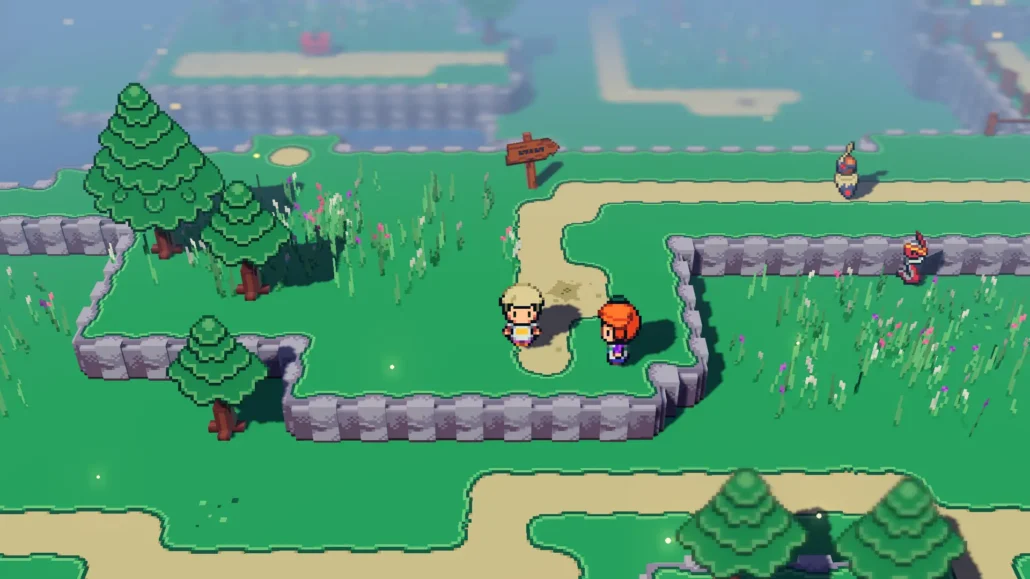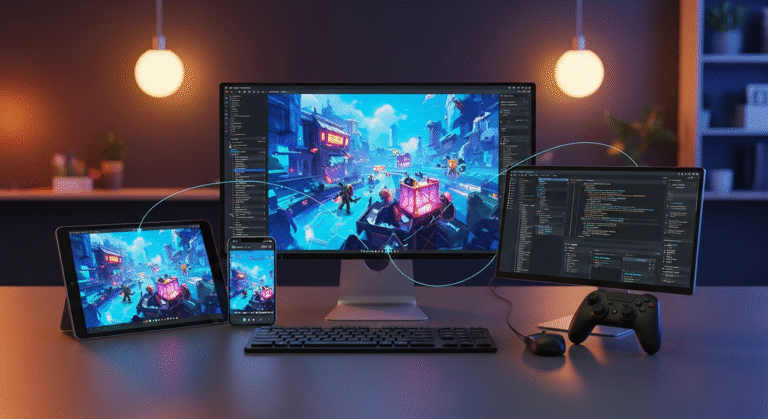The choice between creating in two or three dimensions has moved far beyond simple aesthetic preference or hardware limitations. Today, this decision is a fundamental pillar of a project’s identity, influencing everything from game design constraints to the underlying game production pipelines.
Whether a game art studio is navigating the agile world of indie game development or the high-stakes environment of AAA game development, the choice of dimensionality dictates the player’s psychological connection and the project’s long-term viability.
In this guide, we will examine how these dimensions shape the modern gaming landscape, offering a roadmap for choosing the optimal path.


Need Game Art Services?
Visit our Game Art Service page to see how we can help bring your ideas to life!
How Do Visuals Balance Immersion and Nostalgia in 2D vs 3D Games?
A game’s visual style serves as the primary bridge to the player’s emotions.
- 2D Game Design frequently utilizes abstraction and symbolic art to build its world. Through pixel art or hand-drawn aesthetics, these games tap into a sense of nostalgia while offering a crisp visual clarity that remains unaffected by the march of hardware progress. Because they do not strive for photorealism, 2D titles often age with a certain timeless grace.
- Conversely, 3D Game Design focuses on physical presence, using depth, complex lighting, and camera movement to craft believable environments. Modern game engines like Unreal Engine and Unity have pushed the boundaries of real-time rendering and material science, meeting the high visual demands of contemporary audiences.
However, this pursuit of realism carries higher stakes; 3D assets are often held to a stricter standard of fidelity and can feel dated much sooner than their stylized 2D counterparts.
The choice is essentially a trade-off between the charm of symbolic representation and the power of cinematic realism.
How Does Gameplay Differ Between 2D and 3D Worlds?
The dimensionality of a game world dictates the rules of engagement, influencing everything from how a character moves to how complex the underlying systems can become.
Each dimension offers a specific set of tools for the designer:
2D Gameplay: How Can Simplicity Create Depth?
In the 2D art realm, success is built on the mastery of constraints. By limiting movement to two axes, designers can create incredibly precise challenges that focus on timing and spatial awareness.
This level of control is why platformer games and tactical roguelikes remain so popular; the player always understands exactly why they succeeded or failed.
From a logistical perspective, 2D systems are easier to balance and debug, making them a cornerstone of indie game development where small teams must maximize their impact without the friction of complex camera logic or 3D collision issues.
3D Gameplay: Does Freedom Always Improve Player Experience?
Adding a third dimension introduces unparalleled freedom and the thrill of vertical discovery. Open-world game design thrives on this, allowing players to approach problems from any angle and explore vast, non-linear spaces.
While 3D art‘s freedom fosters deep immersion, it also requires massive technical polish to prevent camera clipping, navigation bugs, or player disorientation. When managed correctly, 3D environments support a level of emergent interaction and grand-scale simulation that 2D simply cannot replicate.
How Does Storytelling Change Between 2D and 3D Games?
The way a narrative design is delivered changes based on the tools available to the developer. 2D games often lean into minimalism, using text and stylized framing to leave room for the player’s imagination.
In contrast, 3D titles are the masters of environmental storytelling. Because players can look around every corner, the world itself becomes a narrator.
2D Storytelling: Suggestion Over Simulation
In the 2D realm, storytelling often relies on the “theatre of the mind.” Minimalist game art visuals and symbolic animations invite players to project their own emotions onto the characters.
By using text, evocative music, and clever framing, 2D titles can deliver narratives that feel deeply personal and interpretive, proving that you don’t need motion capture to create an emotional gut-punch.
3D Storytelling: Performance and Environment as Narrative Tools
3D titles excel at environmental storytelling and performance-driven arcs. With the ability to use cinematic camera angles, subtle facial expressions, and detailed world-building, the narrative often unfolds organically as the player explores.
The world itself becomes a character, with every discarded item or architectural detail whispering parts of the story, allowing for a level of “show, don’t tell” that is difficult to achieve on a flat plane.
Production Pipelines and Costs in 2D vs 3D Games
Economic and logistical factors often weigh as heavily as creative ones. Generally, 2D projects benefit from more streamlined game production pipelines.
AAA game development, however, is frequently synonymous with 3D due to the scale and spectacle expected by the market:
2D Pipelines: Smaller Teams and Faster Iteration
Logistically, 2D projects tend to have more streamlined game production pipelines. Because they bypass the complexities of 3D modeling, rigging, and UV mapping, teams can iterate on ideas much faster.
This agility is a significant boon for indie game development, where limited budgets and small teams require a high degree of efficiency to remain competitive and experimental.
3D Pipelines: Scale and Coordination
Conversely, AAA game development in 3D is a massive undertaking of multidisciplinary coordination. A single character design might pass through the hands of a concept artist, a modeler, a rigger, an animator, and a technical artist before it is functional.
This pipeline is expensive and time-consuming, requiring rigorous project management and optimization to ensure the game runs smoothly across different platforms while maintaining its visual polish.
Where Does Innovation Thrive in 2D and 3D Games?
Innovation takes different forms depending on the dimension. In 2D, the lower cost of entry encourages radical experimentation with mechanics and genre-bending concepts. This is where we often see the most daring “what if” scenarios in gaming.
In the 3D space, innovation is often driven by technological breakthroughs in physics, AI, and procedural generation.
Industry leaders like Nintendo and FromSoftware have demonstrated that high-level 3D design can redefine player expectations, whether through the physics-based puzzles of a sprawling adventure or the intricate, interconnected world-building of an action RPG.
These studios show that when technical power meets strong creative direction, the results can set new standards for the entire industry.
Choosing Between 2D and 3D Games
The line between these two styles is increasingly blurred. We now see 2.5D games that use 3D assets on a 2D plane, or 3D games that utilize fixed cameras to maintain 2D-style precision.
The most successful modern projects choose their dimensionality based on what best serves the player experience rather than following a rigid trend. Whether a game is flat or volumetric is less important than whether that choice supports the core loop and the emotional journey.
Are Hybrid Approaches Replacing the 2D vs 3D Debate?
The boundary between these two worlds is blurring. Many developers now turn to 2.5D Games, which might use 3D models and environments but restrict the gameplay to a 2D axis.
This hybrid approach offers the visual depth and dynamic lighting of 3D while retaining the mechanical precision of 2D. It represents a shift toward “experience-first” design, where the choice of dimension is a tool rather than a strict rule.

Final Words
2D and 3D are not competing technologies but rather different languages of design. Each possesses a unique set of strengths, from the production efficiency and mechanical clarity of 2D to the immersive scale and narrative depth of 3D.
By understanding the inherent challenges of both, developers can make informed decisions that honor their creative vision.
As the industry continues to evolve, the most memorable experiences will likely come from those who know exactly when to embrace the flat plane and when to step into the third dimension.









